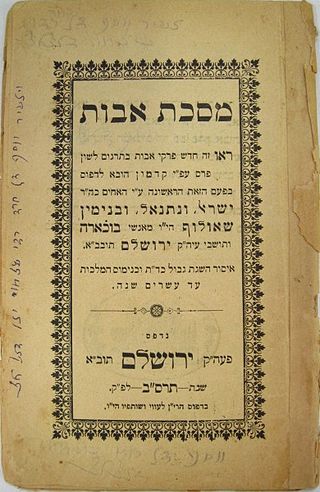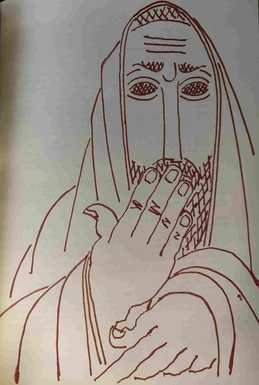Related Research Articles

Judah ha-Nasi or Judah I, known simply as Rebbi or Rabbi, was a second-century rabbi and chief redactor and editor of the Mishnah. He lived from approximately 135 to 217 CE. He was a key leader of the Jewish community in Roman-occupied Judea after the Bar Kokhba revolt.

Akiva ben Joseph, also known as Rabbi Akiva, was a leading Jewish scholar and sage, a tanna of the latter part of the first century and the beginning of the second. Rabbi Akiva was a leading contributor to the Mishnah and to Midrash halakha. He is referred to in Tosafot as Rosh la-Hakhamim. He was executed by the Romans in the aftermath of the Bar Kokhba revolt. He has also been described as a philosopher.
Yohanan ben Zakkai, sometimes abbreviated as ריב״ז ribaz for Rabbi Yohanan ben Zakkai, was a tanna, an important Jewish sage during the late Second Temple period during the transformative post-destruction era. He was a primary contributor to the core text of Rabbinic Judaism, the Mishnah. His name is often preceded by the honorific title Rabban. He is widely regarded as one of the most important Jewish figures of his time, and his escape from the Roman destruction of Jerusalem may have been instrumental in Rabbinic Judaism's survival post-Temple. His tomb is located in Tiberias within the Maimonides burial compound.
Tannaim were the rabbinic sages whose views are recorded in the Mishnah, from approximately 10–220 CE. The period of the Tannaim, also referred to as the Mishnaic period, lasted about 210 years. It came after the period of the Zugot "Pairs" and was immediately followed by the period of the Amoraim "Interpreters".

Pirkei Avot, which translates to English as Chapters of the Fathers, is a compilation of the ethical teachings and maxims from Rabbinic Jewish tradition. It is part of didactic Jewish ethical literature. Because of its contents, the name is sometimes given as Ethics of the Fathers. Pirkei Avot consists of the Mishnaic tractate of Avot, the second-to-last tractate in the order of Nezikin in the Mishnah, plus one additional chapter. Avot is unique in that it is the only tractate of the Mishnah dealing solely with ethical and moral principles; there is relatively little halakha (laws) in Pirkei Avot.
Elisha ben Abuyah was a rabbi and Jewish religious authority born in Jerusalem sometime before 70 CE. After he adopted a worldview considered heretical by his fellow Tannaim, the rabbis of the Talmud refrained from relating teachings in his name and referred to him as the "Other One". In the writings of the Geonim this name appears as "Achor" ("backwards"), because Elisha was considered to have "turned backwards" by embracing heresy.
Rabbi Meir was a Jewish sage who lived in the time of the Mishnah. He was one of the Tannaim of the fourth generation (139–163), and a disciple of Rabbi Akiva. He is the third most frequently mentioned sage in the Mishnah and is mentioned over 3,000 times in the Babylonian Talmud. His wife Bruriah is one of the few women cited in the Gemara.

Johanan HaSandlar was a rabbi who lived in the second century.

Rabbi Tarfon or Tarphon, a Kohen, was a member of the third generation of the Mishnah sages, who lived in the period between the destruction of the Second Temple and the fall of Betar.

Simeon ben Gamliel (I) (Hebrew: שמעון בן גמליאל or רשב"ג הראשון; c. 10 BCE – 70 CE) was a Tanna (sage) and leader of the Jewish people. He served as nasi of the Great Sanhedrin at Jerusalem during the outbreak of the First Jewish–Roman War, succeeding his father in the same office after his father's death in 50 CE and just before the destruction of the Second Temple.
Eliezer ben Hurcanus, also known as Hyrcanus, was one of the most prominent Judean tannaitic Sages of 1st- and 2nd-century Judaism, a disciple of Rabban Yohanan ben Zakkai, and a colleague of Gamaliel II and Joshua ben Hananiah. He is the sixth most frequently mentioned Sage in the Mishnah.
Joshua ben Hananiah, also known as Rabbi Yehoshua, was a leading tanna of the first half-century following the destruction of the Second Temple. He is the eighth-most-frequently mentioned sage in the Mishnah.
Eleazar ben Shammua or Eleazar I was a rabbi of the 2nd century, frequently cited in rabbinic writings as simply Rabbi Eleazar (Bavli) or Rabbi Lazar רִבִּי לָֽעְזָר (Yerushalmi). He was of priestly descent and rich, and acquired great fame as a teacher of traditional law.
Rabbi Yochanan ben Nuri was a tanna of the 1st and 2nd centuries.
Nehunya ben HaKanah was a tanna of the 1st and 2nd centuries.
Eleazar Chisma was a tanna (sage) of the second and third generations. He was a disciple of Joshua ben Hananiah and Gamaliel II.
Simeon ben Eleazar was a Jewish Tanna sage of the fifth generation.
Alon Goshen-Gottstein is a scholar of Jewish studies and a theoretician and activist in the domain of interfaith dialogue. He is founder and director of the Elijah Interfaith Institute since 1997. He specializes in bridging the theological and academic dimension with a variety of practical initiatives, especially involving world religious leadership.

Yehuda Liebes is an Israeli academic and scholar. He is the Gershom Scholem Professor Emeritus of Kabbalah at the Hebrew University of Jerusalem. Considered a leading scholar of Kabbalah, his research interests also include Jewish myth, Sabbateanism, and the links between Judaism and ancient Greek religion, Christianity, and Islam. He is the recipient of the 1997 Bialik Prize, the 1999 Gershom Scholem Prize for Kabbalah Research, the 2006 EMET Prize for Art, Science and Culture, and the 2017 Israel Prize in Jewish thought.

Rabbi Yose Hacohen was a second-generation Tanna who lived at the end of the first century CE, a student of Rabban Yohanan ben Zakkai.
References
- ↑ Avot 2:8; Avot of Rabbi Natan 14:3
- 1 2 Pirkei Avot 2:8; Avot of Rabbi Natan 14:4
- ↑ Goshen-Gottstein, Alon; Badie, Bertrand (2000). The Sinner and the Amnesiac: The Rabbinic Invention of Elisha ben Abuya and Eleazar ben Arach. Stanford University Press. p. 241. ISBN 978-0-8047-3387-8.
- ↑ Goshen-Gottstein, Alon; Badie, Bertrand (2000). The Sinner and the Amnesiac: The Rabbinic Invention of Elisha ben Abuya and Eleazar ben Arach. Stanford University Press. pp. 236–7. ISBN 978-0-8047-3387-8.
- ↑ Yerushalmi, Shemuel, ed. (1976). Avot de-Rabbi Nathan (in Hebrew). Jerusalem: Masoret. p. 69 (Avot de-Rabbi Nathan 22:1). OCLC 232936057.
- ↑ Benjamin of Tudela in Thomas Wright. Early Travels in Palestine . Courier Corporation; 2003. ISBN 978-0-486-42871-0. p. 89.
- ↑ Kedar, Benjamin Z. (2005). Holy Men in a Holy Land: Christian, Muslim and Jewish Religiosity in the Near East at the Time of the Crusades. Hayes Robinson Lecture Series No. 9. London: Royal Holloway, University of London. p. 21.